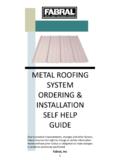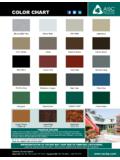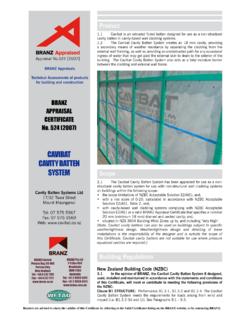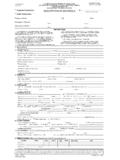Transcription of Polyurea Elastomer Technology: History, …
1 A Presentation by Primeaux Associates LLC 2004, Primeaux Associates LLC1 Polyurea Elastomer Technology: history , chemistry & Basic Formulating TechniquesDudley J. Primeaux IIPrimeaux Associates LLC161 Forest DriveElgin, Texas Polyurea Elastomer coating / lining technology has shown some very significantinroads since the introduction of the technology back in the late 1980 s. Initially, thepolyurea technology had set itself in a different class of coating / lining systems ascompared to conventional urethane coating / lining systems. This has been primarily dueto the unique characteristics of the technology , both in processing and ; over the years there has been a melding of the various technologies, and manyhave now classified or implied that polyureas are the same as urethane and/orurethane/urea systems.
2 There is now a new class of Polyurea systems that have differentprocessing characteristics and some feel that these are not Polyurea systems at all. Theycan t be people say since you don t need the high-pressure plural component processingequipment for application. This has led to some reluctance on the part of engineers andspecifiers to confidently specify Polyurea systems for projects. As a result, there hasbeen some major confusion as to what classifies a system as a Polyurea and, what is paper will take a look at the Polyurea technology , formulation basics ; and, comparethat to what a polyurethane and polyurethane/ Polyurea system is, along with someperformance :Two-component Polyurea elastomeric coating / lining systems are the newest technologyto the protective coating / lining industry.
3 Polyurea systems have sometimes beencharacterized as modified two-component polyurethane systems. While they both mayhave some characteristics in common, Polyurea systems are actually a unique technologyin Polyurea systems are typically known for a very rapid dry time(typically less than 30 seconds), achieved without the use of a catalyst as in the two-component polyurethane systems. This rapid dry time is very consistent / uniform over avery broad ambient temperature range. While the fast reaction / rapid dry time isvirtually unaffected by ambient moisture, the presence of moisture on a substrate must beA Presentation by Primeaux Associates LLC 2004, Primeaux Associates LLC2considered when achieving adhesion to that substrate. This is all made possible by aunique chemistry of raw materials used to develop the two-component Polyurea fast set Polyurea systems typically do not contain any solvent or VolatileOrganic Compounds (VOC).
4 They are normally processed by specialized pluralcomponent equipment, which develops high pressure and high temperature for sprayapplication. The two components are mixed inside the impingement mix spray gun, asthere typically is not any pre-mixing or hot the introduction of the two-component Polyurea technology , a wide variety ofapplications are seen. These include coating / lining applications over concrete, geo-textile membranes, various metals for corrosion and decorative areas as well as someplastics. For all of these, the rapid dry time of the technology means that the area ofapplication can be returned to service rather systems with a slower / modified reactivity and set time are also finding use injoint sealant / filler system applications.
5 Here the material is combined in low pressure,low temperature via folding in a static mix tube and applied as a bead of 2000, the Polyurea Development Association prepared and published a definition ofpolyurea systems. That is identified as follows: A Polyurea coating / Elastomer is that derived from the reaction product of an isocyanatecomponent and a resin blend component. The isocyanate can be aromatic or aliphatic innature. It can be monomer, polymer, or any variant reaction of isocyanates, quasi-prepolymer or a prepolymer. The prepolymer, or quasi-prepolymer, can be made of anamine-terminated polymer resin, or a hydroxyl-terminated polymer resin blend must be made up of amine-terminated polymer resins, and/or amine-terminated chain extenders. The amine-terminated polymer resins will not have anyintentional hydroxyl moieties.
6 Any hydroxyls are the result of incomplete conversion tothe amine-terminated polymer resins. The resin blend may also contain additives, or non-primary components. These additives may contain hydroxyls, such as pre-dispersedpigments in a polyol carrier. Normally, the resin blend will not contain a catalyst(s). Well, that is a mouthful and what does it all mean? This paper will attempt to present abasic overview of the technology and is not meant to be a complete chemistry / technology lesson on polyureas, hybrids and polyurethane BRIEF history of Polyurea DEVELOPMENT:The first actual reference to Polyurea came in 1948 when some researchers wereevaluating thermal properties / melting points of various polymer They werecomparing polyesters, linear polyethylene, polyurethanes, polyamides and polyureas;and, found that the polyureas had far superior thermal properties and an extremely highA Presentation by Primeaux Associates LLC 2004, Primeaux Associates LLC3melting point.
7 Keep in mind that these polymers were manufactured in a laboratoryenvironment and were not very conducive to coating / lining applications. Figure 1 is agraphical depiction of the melting points of various polymers for 1: Trend of Crystalline Melting Points in Homologous Polymer ChainsThe two-component Polyurea elastomeric coating / lining technology is a derivation ofthe Polyurea Reaction Injection Molding (RIM) technology developed in the early1980 Polyurea RIM was used to produce a variety of automotive exterior body paneland fascia (bumper covers) parts. The most noted use was in the Pontiac Fiero, whichemployed the space frame concept. Other parts included fascia for the Camaro, Firebird /TransAm, Corvette, Pontiac Bonneville and GrandAm, and rear quarter panels / fendersfor the dually trucks, like Ford, Dodge and Presentation by Primeaux Associates LLC 2004, Primeaux Associates LLC4 Figure 2: Polyurea RIMThe advantages or unique characteristics of Polyurea over polyurethane andpolyurethane/ Polyurea hybrid system in RIM applications included rapid molding / curetime which was typically 2 3 second set or gel times with a dry time of less than 10seconds.
8 Also realized was reduced part scrap rate and most importantly, the ability topaint the parts using the online Electrophoritic Paint Deposition (ELPO) process. Thisprocess involved heating the parts to almost 400 F (205 C), a temperature that was verydetrimental to a polyurethane and most hybrid systems. Polyurea systems are noted fortheir high thermal stability. The two-component fast set Polyurea coating / lining technology was first introduced tothe industry in 1988, following the development in ,5 This technology evolvedfrom the need to develop a more stable, durable and 100% solids polymer system forcoating rigid, spray applied polyurethane foam used in roofing and other insulationapplications. Some of the first plural component spray applied Polyurea formulations hadget times of 1 2 secs, with tack free of < 10 secs.
9 The actual first commercialapplication of the Polyurea elastomeric coating / lining technology was as a roofingsystem in , this was not the first actual work with the spray applied two-componentpolyurea technology . Earlier work in the 1970 s utilized modified polyamines and highlevels of plasticizers and solvents to achieve a sprayable system for coating Whilethis proved successful in laboratory applications, poor field performance was noted andthis technology never gained unique, solvented Polyurea / epoxy / urethane hybrid type system was also utilized inthe 1970 s for production of a composite traction Other uses includedtemporary shelters, roofing and blast protection. This was not a true Polyurea Presentation by Primeaux Associates LLC 2004, Primeaux Associates LLC5In 1998, the National Association of Corrosion Engineers (NACE) issued a TechnicalReport on Polyurea systems in an attempt to give an initial description / comparison ofpolyureas to This document gives a very general view of the technology ,with limited basic details as to the chemistry chemistry / FORMULATION:Since we have been focusing our efforts on defining the technology , we need to identifywhat part of the technology / reaction we are looking to that classifies whether a polyureaor not.
10 The consensus seems to be that we are looking at a 2-part processed system,whether it was spray, caulk, pour or RIM processed. Therefore, the identifying reactionwould be the reaction that takes place between the 2-part system, the reaction of thepolyisocyanate component and the resin blend component. This would be thepolymerization / curing part. This is a thermoset main distinguishing characteristic with the Polyurea technology over polyurethanesis that amine terminated (-NH2) resins are used rather than hydroxyl terminated (-OH)resins, commonly referred to as polyols. The reaction of the amine terminated resins withthe isocyanate component results in the formation of a urea linkage. Since this is apolymer and these units repeat, the term Polyurea then applies.







